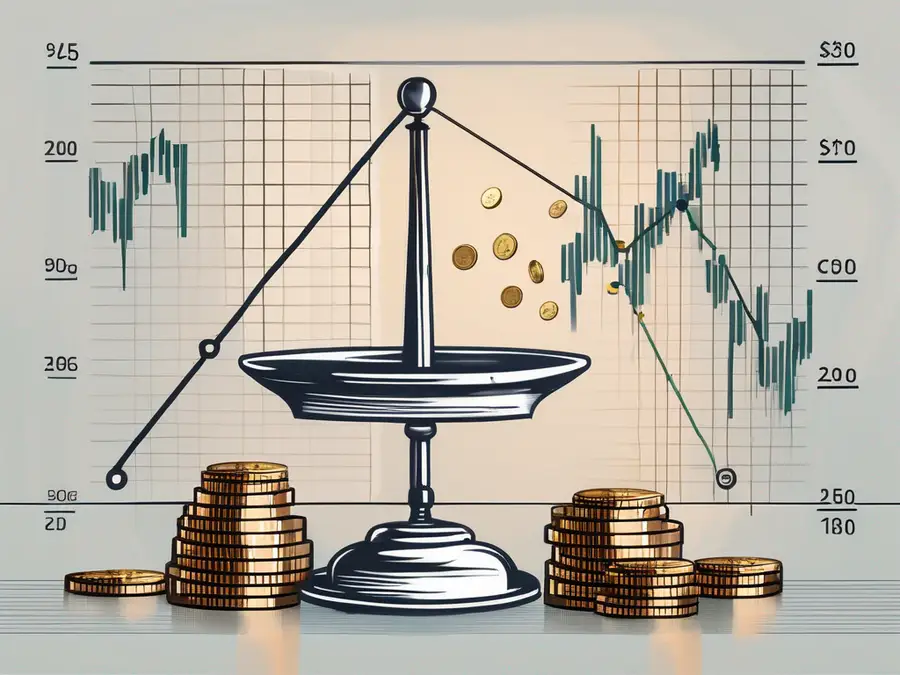Understanding the Significance of Sortino Ratio in Investment Analysis

In the world of investment analysis, there are numerous tools and ratios that analysts use to assess the risk and performance of an investment. One such ratio that has gained increasing attention is the Sortino Ratio. Understanding this ratio and its significance is crucial for investors and financial professionals alike. In this article, we will delve into the details of the Sortino Ratio, its role in risk assessment, its comparison with other tools, its practical applications, as well as its limitations and criticisms.
Defining the Sortino Ratio
The Sortino Ratio is a risk-adjusted measure that helps investors evaluate the return earned for a given level of downside risk. It is a widely used tool in the world of finance to assess the performance of an investment. Unlike other ratios that consider total volatility, the Sortino Ratio focuses solely on downside volatility, which is seen as a more accurate reflection of a negative outcome for investors.
Investing in financial markets always carries some level of risk. The Sortino Ratio takes into account the fact that investors are particularly concerned about the downside risk, as it represents the potential loss they could incur. By focusing on downside volatility, this ratio provides a more nuanced understanding of an investment's performance.
The Mathematical Formula Behind Sortino Ratio
The Sortino Ratio is calculated by dividing the excess return of an investment over the risk-free rate by the downside deviation. The excess return represents the return earned above the risk-free rate, while the downside deviation measures the volatility of returns below a certain target return.
Let's break down the formula further. The excess return is obtained by subtracting the risk-free rate from the actual return of the investment. This difference represents the additional return that the investor has earned by taking on the risk associated with the investment. On the other hand, the downside deviation is calculated by considering only the returns that fall below a specified target return. This allows for a more precise assessment of the risk associated with the investment.
By dividing the excess return by the downside deviation, the Sortino Ratio provides a measure of how much return an investor is earning for each unit of downside risk taken. This ratio is particularly useful for investors who are risk-averse and want to evaluate the risk-reward tradeoff of their investments.
Key Components of the Sortino Ratio
The Sortino Ratio relies on two key components: the target return and the risk-free rate. The target return is the minimum acceptable return that an investor expects. It serves as a benchmark against which the actual return of the investment is compared. If the actual return falls below the target return, it indicates that the investment has not met the investor's expectations.
The risk-free rate, on the other hand, is the return on an investment considered to have no risk. It is typically represented by the yield of a government bond, as these bonds are generally considered to be the safest investment option. By subtracting the risk-free rate from the actual return, the excess return captures the additional return earned by taking on the risk associated with the investment.
Both the target return and the risk-free rate are crucial in calculating the Sortino Ratio, as they provide the necessary context for evaluating an investment's performance. The target return sets the standard against which the investment is assessed, while the risk-free rate helps determine the excess return.
In conclusion, the Sortino Ratio is a valuable tool for investors to assess the risk-adjusted return of their investments. By focusing on downside volatility and incorporating the target return and risk-free rate, this ratio provides a comprehensive analysis of an investment's performance. It allows investors to make more informed decisions and evaluate the risk-reward tradeoff of their portfolio.
The Role of Sortino Ratio in Risk Assessment
Risk assessment is a critical aspect of investment analysis, and the Sortino Ratio plays a vital role in this process. By differentiating between good and bad volatility, it provides a more accurate measure of an investment's risk-adjusted performance.
Differentiating Between Good and Bad Volatility
Volatility is often perceived as a negative attribute by investors. However, not all volatility is bad. The Sortino Ratio helps distinguish between good volatility, which represents a temporary deviation from the target return, and bad volatility, which contributes to a permanent loss of capital.
Good volatility can occur when an investment experiences short-term fluctuations that do not significantly impact its long-term performance. For example, a stock may experience a sudden price drop due to market sentiment or news events, but if the underlying fundamentals of the company remain strong, the stock price is likely to recover in the future. The Sortino Ratio takes into account these temporary deviations and provides a more nuanced assessment of an investment's risk.
On the other hand, bad volatility represents a sustained decline in an investment's value, often due to fundamental weaknesses or adverse market conditions. This type of volatility can lead to permanent capital loss and is a crucial factor to consider in risk assessment. The Sortino Ratio helps investors identify investments with a higher likelihood of experiencing bad volatility, allowing them to make more informed decisions.
Understanding Downside Risk
Downside risk refers to the potential for an investment to experience losses below a certain threshold. The Sortino Ratio takes into account downside risk and provides a more detailed assessment of an investment's performance in adverse conditions.
When evaluating an investment, it is important to consider not only its potential for positive returns but also the likelihood and magnitude of potential losses. The Sortino Ratio focuses on downside risk by only considering the standard deviation of negative returns, rather than the total standard deviation. This approach provides a more accurate measure of an investment's risk in unfavorable market conditions.
By incorporating downside risk into the risk assessment process, the Sortino Ratio helps investors gain a better understanding of an investment's performance during market downturns. This information can be particularly valuable for risk-averse investors who prioritize capital preservation and seek investments with lower downside risk.
In conclusion, the Sortino Ratio is an essential tool in risk assessment as it differentiates between good and bad volatility and considers downside risk. By providing a more comprehensive analysis of an investment's risk-adjusted performance, it enables investors to make more informed decisions and build portfolios that align with their risk tolerance and investment objectives.
Comparing Sortino Ratio with Other Risk-Assessment Tools
While the Sortino Ratio is a valuable tool in investment analysis, it is important to compare it with other commonly used measures to gain a comprehensive understanding of risk.
When it comes to assessing risk, there are several tools available to investors. One widely recognized measure is the Sharpe Ratio, which, like the Sortino Ratio, takes into account the risk-free rate and volatility. However, there is a key difference between the two.
Sortino Ratio Vs. Sharpe Ratio
The Sharpe Ratio considers total volatility, encompassing both upside and downside movements. It provides a measure of risk-adjusted return by comparing the excess return of an investment to its overall volatility. On the other hand, the Sortino Ratio focuses solely on downside risk, specifically the volatility associated with negative returns.
By concentrating on downside risk, the Sortino Ratio offers a more targeted assessment of a portfolio's performance. This makes it particularly useful in situations where minimizing losses is a top priority. For example, in conservative investment strategies or during market downturns, the Sortino Ratio can provide valuable insights into the potential downside of an investment.
Benefits of Using Sortino Ratio Over Standard Deviation
Another commonly used measure of volatility is standard deviation. While it is a useful tool, it fails to differentiate between upside and downside volatility. This is where the Sortino Ratio shines.
The Sortino Ratio incorporates downside deviation, which measures the volatility associated with negative returns. By considering only downside volatility, it provides a more insightful picture of a portfolio's risk-adjusted performance. This is especially important for investors who are primarily concerned with protecting their capital and minimizing losses.
For example, let's consider two portfolios with the same standard deviation. Portfolio A has a higher frequency of positive returns, while Portfolio B has a higher frequency of negative returns. The standard deviation alone would not capture this difference, but the Sortino Ratio would. It would highlight the higher downside volatility of Portfolio B, indicating that it carries more risk despite having the same standard deviation as Portfolio A.
In conclusion, while the Sortino Ratio is a valuable risk-assessment tool, it is essential to compare it with other measures such as the Sharpe Ratio and standard deviation. Each tool provides a different perspective on risk, allowing investors to make more informed decisions based on their specific investment goals and risk tolerance.
Practical Application of Sortino Ratio in Investment Analysis
Understanding how to apply the Sortino Ratio in real-world investment scenarios is vital for investors and financial professionals. The Sortino Ratio, a variation of the Sharpe Ratio, is a risk-adjusted measure that focuses on downside risk. It provides a more accurate assessment of an investment's performance by considering only the negative deviation from the target return, rather than the total volatility.
But how exactly can the Sortino Ratio be used in practice? Let's delve deeper into its practical applications in investment analysis.
Evaluating Portfolio Performance with Sortino Ratio
The Sortino Ratio can be used to evaluate the performance of a portfolio by comparing the risk-adjusted returns of different investments. Traditional performance measures, such as the simple return or the Sharpe Ratio, do not differentiate between upside and downside volatility. However, the Sortino Ratio takes into account only the downside risk, which is particularly important for risk-averse investors.
For example, let's say you have two investment portfolios with similar average returns. Portfolio A has a higher standard deviation, indicating higher overall volatility, while Portfolio B has a lower standard deviation, indicating lower overall volatility. By calculating the Sortino Ratio for both portfolios, you can determine which one provides a better risk-adjusted return, considering only the downside deviation from the target return.
This evaluation method is especially useful for investors who prioritize capital preservation and are more concerned about the potential losses rather than the potential gains.
Making Investment Decisions Based on Sortino Ratio
When making investment decisions, investors can consider the Sortino Ratio to assess the potential downside risk of an investment. By focusing on the downside volatility, the Sortino Ratio helps investors identify investments that may be more suitable for their risk tolerance.
For instance, suppose you are considering two investment options: Option X and Option Y. Option X has a higher average return but also a higher downside deviation, while Option Y has a slightly lower average return but a lower downside deviation. By calculating the Sortino Ratio for both options, you can evaluate which investment has a better risk-adjusted return, taking into account the potential losses.
It's important to note that the Sortino Ratio should not be the sole factor in making investment decisions. It should be used in conjunction with other financial analyses, such as fundamental analysis, technical analysis, and consideration of the investment's underlying assets and market conditions. By combining multiple perspectives, investors can make more informed and prudent investment choices.
In conclusion, the Sortino Ratio is a valuable tool for investment analysis, providing a more accurate assessment of an investment's performance by focusing on downside risk. By evaluating portfolio performance and making investment decisions based on the Sortino Ratio, investors can better align their investment strategies with their risk tolerance and financial goals.
Limitations and Criticisms of the Sortino Ratio
While the Sortino Ratio is a valuable tool, it is essential to be aware of its limitations and criticisms.
Potential Misinterpretations of Sortino Ratio
One potential misinterpretation of the Sortino Ratio is the assumption that a higher ratio always indicates a better investment. It is important to consider other factors such as the investment's risk profile and investment objectives before drawing conclusions solely based on the Sortino Ratio.
The Debate Over the Ideal Target Return
The Sortino Ratio heavily relies on the selection of the target return. Determining the ideal target return can be subjective and can vary depending on individual investor preferences and market conditions. This subjectivity has led to some criticism of the ratio.
As an investment professional, I have found the Sortino Ratio to be a valuable tool in assessing risk and making informed investment decisions. It provides a more nuanced perspective on downside risk, allowing me to better evaluate the performance of different investments. I always advocate for a holistic approach to investment analysis, considering multiple factors alongside the Sortino Ratio to create a well-rounded investment strategy.
FAQ
What is the Sortino Ratio?
The Sortino Ratio is a risk-adjusted measure that helps investors evaluate the return earned for a given level of downside risk. It focuses solely on downside volatility, which is seen as a more accurate reflection of a negative outcome for investors.
How is the Sortino Ratio calculated?
The Sortino Ratio is calculated by dividing the excess return of an investment over the risk-free rate by the downside deviation. The excess return represents the return earned above the risk-free rate, while the downside deviation measures the volatility of returns below a certain target return.
Why is the Sortino Ratio important?
The Sortino Ratio is important because it provides a more accurate measure of an investment's risk-adjusted performance. By differentiating between good and bad volatility and focusing on downside risk, it offers a more insightful assessment of an investment's performance in adverse conditions.
As you consider the insights provided by the Sortino Ratio in optimizing your investment strategy, explore the innovative trading possibilities with Morpher. Embrace the future of investing on a platform that offers zero fees, infinite liquidity, and the flexibility of fractional investing and short selling. With Morpher, you gain the safety and control you need, along with the option to leverage your trades up to 10x. Experience a unique trading environment built on the Ethereum Blockchain, where you can diversify across various asset classes effortlessly. Sign Up and Get Your Free Sign Up Bonus today, and join the community of traders who are already leveraging Morpher's revolutionary platform to enhance their investment journey.

Disclaimer: All investments involve risk, and the past performance of a security, industry, sector, market, financial product, trading strategy, or individual’s trading does not guarantee future results or returns. Investors are fully responsible for any investment decisions they make. Such decisions should be based solely on an evaluation of their financial circumstances, investment objectives, risk tolerance, and liquidity needs. This post does not constitute investment advice.

Painless trading for everyone
Hundreds of markets all in one place - Apple, Bitcoin, Gold, Watches, NFTs, Sneakers and so much more.

Painless trading for everyone
Hundreds of markets all in one place - Apple, Bitcoin, Gold, Watches, NFTs, Sneakers and so much more.









